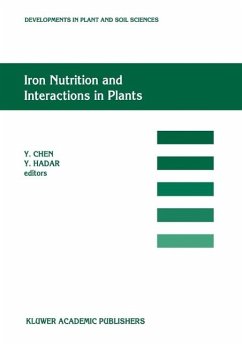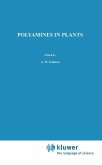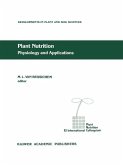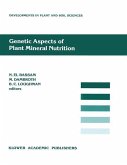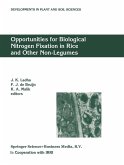Iron Nutrition and Interactions in Plants (eBook, PDF)
"Proceedings of the Fifth International Symposium on Iron Nutrition and Interactions in Plants", 11-17 June 1989, Jerusalem, Israel, 1989
Redaktion: Chen, Y.; Hadar, Y.


Alle Infos zum eBook verschenken

Iron Nutrition and Interactions in Plants (eBook, PDF)
"Proceedings of the Fifth International Symposium on Iron Nutrition and Interactions in Plants", 11-17 June 1989, Jerusalem, Israel, 1989
Redaktion: Chen, Y.; Hadar, Y.
- Format: PDF
- Merkliste
- Auf die Merkliste
- Bewerten Bewerten
- Teilen
- Produkt teilen
- Produkterinnerung
- Produkterinnerung

Hier können Sie sich einloggen

Bitte loggen Sie sich zunächst in Ihr Kundenkonto ein oder registrieren Sie sich bei bücher.de, um das eBook-Abo tolino select nutzen zu können.
Many agricultural crops worldwide, especially in semi-arid climates, suffer from iron deficiencies. Among plants sensitive to iron deficiency are apples, avocado, bananas, barley, beans, citrus, cotton, grapes, peanuts, pecans, potatoes, sorghum, soybeans, and numerous ornamental plants. Deficiencies are usually recognized by chlorotic, in new leaves and are typically found among sensitive crops grown in calcareous or yellowed, interveinal areas soils which cover over 30% of the earth's land surface. Iron deficiency may lead, in extreme cases, to complete crop failure. In intensive agriculture…mehr
- Geräte: PC
- ohne Kopierschutz
- eBook Hilfe
- Größe: 45.86MB
![Polyamines in Plants (eBook, PDF) Polyamines in Plants (eBook, PDF)]() Polyamines in Plants (eBook, PDF)161,95 €
Polyamines in Plants (eBook, PDF)161,95 €![Iron Nutrition in Soils and Plants (eBook, PDF) Iron Nutrition in Soils and Plants (eBook, PDF)]() Iron Nutrition in Soils and Plants (eBook, PDF)233,95 €
Iron Nutrition in Soils and Plants (eBook, PDF)233,95 €![Plant Nutrition - Physiology and Applications (eBook, PDF) Plant Nutrition - Physiology and Applications (eBook, PDF)]() Plant Nutrition - Physiology and Applications (eBook, PDF)73,95 €
Plant Nutrition - Physiology and Applications (eBook, PDF)73,95 €![Tree Root Systems and Their Mycorrhizas (eBook, PDF) Tree Root Systems and Their Mycorrhizas (eBook, PDF)]() Tree Root Systems and Their Mycorrhizas (eBook, PDF)161,95 €
Tree Root Systems and Their Mycorrhizas (eBook, PDF)161,95 €![Genetic Aspects of Plant Mineral Nutrition (eBook, PDF) Genetic Aspects of Plant Mineral Nutrition (eBook, PDF)]() N. El BassamGenetic Aspects of Plant Mineral Nutrition (eBook, PDF)233,95 €
N. El BassamGenetic Aspects of Plant Mineral Nutrition (eBook, PDF)233,95 €![Opportunities for Biological Nitrogen Fixation in Rice and Other Non-Legumes (eBook, PDF) Opportunities for Biological Nitrogen Fixation in Rice and Other Non-Legumes (eBook, PDF)]() J. K. LadhaOpportunities for Biological Nitrogen Fixation in Rice and Other Non-Legumes (eBook, PDF)40,95 €
J. K. LadhaOpportunities for Biological Nitrogen Fixation in Rice and Other Non-Legumes (eBook, PDF)40,95 €![The Supporting Roots of Trees and Woody Plants: Form, Function and Physiology (eBook, PDF) The Supporting Roots of Trees and Woody Plants: Form, Function and Physiology (eBook, PDF)]() The Supporting Roots of Trees and Woody Plants: Form, Function and Physiology (eBook, PDF)161,95 €
The Supporting Roots of Trees and Woody Plants: Form, Function and Physiology (eBook, PDF)161,95 €-
-
-
Dieser Download kann aus rechtlichen Gründen nur mit Rechnungsadresse in A, B, BG, CY, CZ, D, DK, EW, E, FIN, F, GR, HR, H, IRL, I, LT, L, LR, M, NL, PL, P, R, S, SLO, SK ausgeliefert werden.
- Produktdetails
- Verlag: Springer Netherlands
- Seitenzahl: 380
- Erscheinungstermin: 6. Dezember 2012
- Englisch
- ISBN-13: 9789401132947
- Artikelnr.: 44064530
- Verlag: Springer Netherlands
- Seitenzahl: 380
- Erscheinungstermin: 6. Dezember 2012
- Englisch
- ISBN-13: 9789401132947
- Artikelnr.: 44064530
